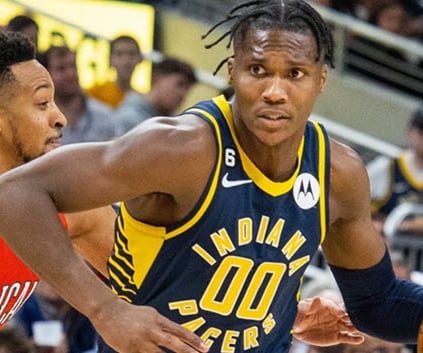Out
Injury Wrist
Est. Return 11/16/2025
2025 Stats
PTS
0.0
REB
0.0
AST
0.0
STL
0.0
BLK
0.0
ROS Projections
2025 Fantasy Outlook
After two strong seasons with the Spurs, where Collins flirted with top-150 fantasy value in category leagues, the veteran big man fell out of favor in San Antonio last year and was shipped to Chicago. With Nikola Vucevic sidelined, Collins drew eight straight starts from late February to mid-March, averaging 14.9 points, 9.8 rebounds, 3.3 assists, 1.6 stocks and 1.3 made three-pointers in 28.8 minutes per game while posting 59/37/84 shooting splits. His role diminished significantly when Vucevic returned, posting 6.0 points, 5.2 rebounds, 0.7 stocks and 0.4 made three-pointers in 15.8 minutes during the final 18 games, including the Play-In Tournament. Vucevic hardly ever misses games, but he has been a frequent flier in the rumor mill. Rostering Collins strictly as an insurance piece in standard leagues is ironically risky, but he's worth monitoring on the waiver wire, especially in category leagues due to his ability to make three-pointers. However, after shooting 36.7 percent on three-point tries from 2019-2022-23, Collins has shot only 31.4 percent the past two seasons. In two-center leagues, Collins should be your fourth or fifth center. Collins will be sidelined for at least four weeks due to a left wrist fracture he suffered during the peaseason finale. Read Past Outlooks

Out at least four weeks
Collins will be sidelined for at least four weeks due to a left wrist fracture, Mike McGraw of the Chicago Daily Herald reports.
ANALYSIS
This injury occurred in Chicago's preseason finale and required surgery. Based on this timetable, the earliest Collins will be able to return is Nov. 16 against the Jazz. Collins was projected to open the regular season as the backup center behind Nikola Vucevic, but those minutes may fall to Jalen Smith to begin the campaign. The Bulls could also opt for smaller and quicker lineups.
This injury occurred in Chicago's preseason finale and required surgery. Based on this timetable, the earliest Collins will be able to return is Nov. 16 against the Jazz. Collins was projected to open the regular season as the backup center behind Nikola Vucevic, but those minutes may fall to Jalen Smith to begin the campaign. The Bulls could also opt for smaller and quicker lineups.
NBA Per Game Stats
Per Game
Total
Per 36
NBA Per Game Stats
Loading Per Game Stats...
2024 NBA Game Log
2024
2023
2022
2021
2019
2018
2017
2025 NBA Per Game Split Stats
Schedule
By Month
Starting/Off Bench
Days Rest
Vs Opp
By Result
2025 NBA Per Game Split Stats
Loading Split Stats...
Advanced Stats
Loading Advanced Stats...
Stat Review
2024
2023
2022
2021
2019
2018
2017
How does Zach Collins compare to other players?
This section compares his stats with all players from the previous three seasons (minimum 200 minutes played)*. The bar represents the player's percentile rank. For example, if the bar is halfway across, then the player falls into the 50th percentile for that stat and it would be considered average.
True Shooting %
56.6%
Effective Field Goal %
51.5%
3-Point Attempt Rate
34.8%
Free Throw Rate
26.5%
Offensive Rebound %
9.6%
Defensive Rebound %
15.9%
Total Rebound %
12.7%
Assist %
16.9%
Steal %
1.4%
Block %
3.2%
Turnover %
10.3%
Usage %
17.1%
Fantasy Points Per Game
12.0
Fantasy Points Per Minute
1.0
NBA Historical Fantasy Stats
Historical ADP
Loading Historical ADP...
Bulls Depth Chart
Our full team depth charts are reserved for RotoWire subscribers.
Subscribe Now
Bulls Rotation: Minutes Breakdown
Loading Bulls Rotation Data...
Average Fantasy Points
Minutes
FanDuel
DraftKings
Yahoo
FantasyDraft
Head2Head
Sorare
Average Fantasy Points are determined when Zach Collins was active vs. non-active during the season. Click here to view average fantasy points for a different time period.
Loading Average Minutes...
Past Fantasy Outlooks
2024
2023
2022
2021
2020
2019
2018
2017
Collins averaged 11.2 points, 5.4 rebounds, 2.8 assists and 0.8 blocks per game across 69 regular-season appearances in the 2023-24 season, including a career-high 29 starts. He's working his way back from an offseason shoulder surgery but should be available for the start of training camp. It's easy to read Collins' numbers in 2023-24 as a success, as he opened the previous campaign as a starter to ease Victor Wembanyama into the league as a rookie, but now that the Frenchman is fully settled as one of the most dominant players in The Association, Collins is slated to be a backup once again in 2024-25 -- even if he's fully healthy. That's going to limit his minutes considerably, and considering the Spurs also have Jeremy Sochan, Keldon Johnson and even Harrison Barnes as potential frontcourt options, Collins isn't expected to have a lot of minutes. As such, he shouldn't be a target in fantasy outside of the very deep formats, where he could be a solid option to be a third or fourth center.
More Fantasy News

In reserve role Sunday
Collins will come off the bench during Sunday's preseason game against the Bucks, Joel Lorenzi of The Athletic reports.
ANALYSIS
Subscribe now to instantly reveal our take on this news.
Subscribe now to instantly reveal our take on this news.

Running with starters Thursday
Collins is in the starting lineup for Thursday's preseason game against the Cavaliers.
ANALYSIS
Subscribe now to instantly reveal our take on this news.
Subscribe now to instantly reveal our take on this news.

Highly efficient in preseason win
Collins finished with 16 points (7-8 FG, 1-2 3Pt, 1-1 FT), two rebounds and three assists across 14 minutes during Tuesday's 118-117 preseason win over the Cavaliers.
ANALYSIS
Subscribe now to instantly reveal our take on this news.
Subscribe now to instantly reveal our take on this news.

Plays five minutes
Collins chipped in two points (1-1 FG) and one assist over five minutes during Wednesday's 109-90 Play-In Game loss to the Heat.
ANALYSIS
Subscribe now to instantly reveal our take on this news.
Subscribe now to instantly reveal our take on this news.

Pulls down eight boards
Collins chipped in four points (2-6 FG, 0-2 3Pt), eight rebounds and two assists across 15 minutes during Sunday's 131-117 victory over the Hornets.
ANALYSIS
Subscribe now to instantly reveal our take on this news.
Subscribe now to instantly reveal our take on this news.
Latest Fantasy Rumors

On his way out of Chicago?
Collins could leave the Bulls during the offseason, according to Joe Cowley of The Chicago Sun-Times.
ANALYSIS
The Bulls have a bit of a logjam at center since they have Collins, Nikola Vucevic and Jalen Smith under center. Vucevic is the best offensive option, and Smith is a stretch-four, but Collins can be a serviceable backup, so he might be retained on a cheap deal. He'll be in the final year of his contract in 2025-26.
The Bulls have a bit of a logjam at center since they have Collins, Nikola Vucevic and Jalen Smith under center. Vucevic is the best offensive option, and Smith is a stretch-four, but Collins can be a serviceable backup, so he might be retained on a cheap deal. He'll be in the final year of his contract in 2025-26.












